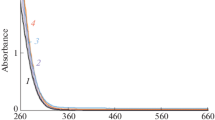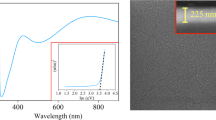Abstract
In order to lower the heating temperature, inorganic-organic hybrid films prepared by a sol-gel process are attractive candidates for glaze. Here, we prepared the inorganic-organic hybrid thick films on glass substrates by the sol-gel process at 100 °C. The precursor sol was prepared by hydrolysis and condensation of 3-glycidoxypropyltrimethoxysilane (GPTMS) and zirconium propoxide chemically modified with acetylacetone. The obtained GPTMS-ZrO2-based thick films had a transmittance higher than 80% in the visible light of 390–800 nm. Thick films with a pencil hardness of 5H and a thickness of more than 100 µm were obtained.

Graphical abstract
Highlights
-
3-glycidoxypropyltrimethoxysilane (GPTMS)-based inorganic-organic hybrid thick films were prepared by a casting process.
-
Transmittance of the films was higher than 80% in the visible light of 390–800 nm.
-
Pencil hardness of the films was increased by the introduction of Zr–O bonds in GPTMS-derived polysiloxane.
-
Thick films with a pencil hardness of 5H and a thickness of more than 100 µm were obtained.




Similar content being viewed by others
Change history
28 July 2022
A Correction to this paper has been published: https://doi.org/10.1007/s10971-022-05883-0
References
Pradell T, Molera J (2020) Ceramic technology. How to characterise ceramic glazes. Archaeol Anthropol Sci 12:189. https://doi.org/10.1007/s12520-020-01136-9
Xu DM, Zhang KDA, Zhu XL (2004) A novel dendritic acrylate oligomer: Synthesis and UV curable properties. J Appl Polym Sci 92:1018–1022. https://doi.org/10.1002/app.20069
Charitidis C, Gioti M, Logothetidis S et al. (2004) Comparison of the nanomechanical and nanoscratch performance of antiscratch layers on organic lenses. Surf Coat Technol 180–181:357–361. https://doi.org/10.1016/j.surfcoat.2003.10.088
Pomázi Á, Toldy A (2021) Development of fire retardant epoxy-based gelcoats for carbon fibre reinforced epoxy resin composites. Prog Org Coat 151:106015. https://doi.org/10.1016/j.porgcoat.2020.106015
Fieberg A, Reis O (2002) UV curable electrodeposition systems. Prog Org Coat 45:239–247. https://doi.org/10.1016/S0300-9440(02)00065-6
Lin D, Kou H, Shi WF et al. (2001) Photopolymerizaton of hyperbranched aliphatic acrylated poly(amide ester). II. Photopolymerization kinetics. J Appl Polym Sci 82:1637–1641. https://doi.org/10.1002/app.2003
Mammeri F, Le Bourhis E, Rozes L, Sanchez C (2005) Mechanical properties of hybrid organic-inorganic materials. J Mater Chem 15:3787–3811. https://doi.org/10.1039/b507309j
Que W, Zhang QY, Chan YC, Kam CH (2003) Sol-gel derived hard optical coating via organic/inorganic composites. Compos Sci Technol 63:347–351. https://doi.org/10.1016/S0266-3538(02)00227-0
Sasaki T, Kamitani K (2008) Preparation of thick and hard coating films via sol-gel process with a low temperature treatment. J Sol-Gel Sci Technol 46:180–189. https://doi.org/10.1007/s10971-008-1685-4
Kozuka H, Nakajima K, Uchiyama H (2013) Superior properties of silica thin films prepared from perhydropolysilazane solutions at room temperature in comparison with conventional alkoxide-derived silica gel films. ACS Appl Mater Interfaces 5:8329–8336. https://doi.org/10.1021/am400845y
Rosero-Navarro NC, Curioni M, Castro Y et al. (2011) Glass-like CexOy sol-gel coatings for corrosion protection of aluminium and magnesium alloys. Surf Coat Technol 206:257–264. https://doi.org/10.1016/j.surfcoat.2011.07.006
Zaharescu M, Predoana L, Barau A et al. (2009) SiO2 based hybrid inorganic-organic films doped with TiO2-CeO2 nanoparticles for corrosion protection of AA2024 and Mg-AZ31B alloys. Corros Sci 51:1998–2005. https://doi.org/10.1016/j.corsci.2009.05.022
Correa PS, Malfatti CF, Azambuja DS (2011) Corrosion behavior study of AZ91 magnesium alloy coated with methyltriethoxysilane doped with cerium ions. Prog Org Coat 72:739–747. https://doi.org/10.1016/j.porgcoat.2011.08.005
Hu RG, Zhang S, Bu JF et al. (2012) Recent progress in corrosion protection of magnesium alloys by organic coatings. Prog Org Coat 73:129–141. https://doi.org/10.1016/j.porgcoat.2011.10.011
Zomorodian A, Brusciotti F, Fernandes A et al. (2012) Anti-corrosion performance of a new silane coating for corrosion protection of AZ31 magnesium alloy in Hank’s solution. Surf Coat Technol 206:4368–4375. https://doi.org/10.1016/j.surfcoat.2012.04.061
Lamaka SV, Montemor MF, Galio AF et al. (2008) Novel hybrid sol-gel coatings for corrosion protection of AZ31B magnesium alloy. Electrochim Acta 53:4773–4783. https://doi.org/10.1016/j.electacta.2008.02.015
Hasegawa K, Kunugi S, Tatsumisago M, Minami T (1999) Preparation of thick films by electrophoretic deposition using surface modified silica particles derived from sol-gel method. J Sol-Gel Sci Technol 15:243–249. https://doi.org/10.1023/A:1008789025826
Aparicio M, Mosa J, Rodriguez G et al. (2019) Consolidated melting gel coatings on AZ31 magnesium alloy with excellent corrosion resistance in nacl solutions: an interface study. ACS Appl Mater Interfaces 11:3493–3505. https://doi.org/10.1021/acsami.8b20199
Katagiri K, Hasegawa K, Matsuda A et al. (1998) Preparation of transparent thick films by electrophoretic sol-gel deposition using phenyltriethoxysilane-derived particles. J Am Ceram Soc 81:2501–2503. https://doi.org/10.1111/j.1151-2916.1998.tb02653.x
Feng Z, Liu Y, Thompson GE, Skeldon P (2010) Crack-free sol-gel coatings for protection of AA1050 aluminium alloy. Surf Interface Anal 42:306–310. https://doi.org/10.1002/sia.3162
Tadanaga K, Yoshida H, Matsuda A et al. (2003) Preparation of proton-conductive inorganic-organic hybrid films from 3-glycidoxypropyltrimethoxysilane and orthophosphoric acid. Chem Mater 15:1910–1912. https://doi.org/10.1021/cm020692l
Tezuka T, Tadanaga K, Matsuda A et al. (2005) Utilization of glass papers as a support for proton conducting inorganic-organic hybrid membranes from 3-glycidoxypropyltrimethoxysilane, tetraalkoxysilane and orthophosphoric acid. Solid State Ion 176:3001–3004. https://doi.org/10.1016/j.ssi.2005.09.039
Daniels MW, Francis LF (1998) Silane adsorption behavior, microstructure, and properties of glycidoxypropyltrimethoxysilane-modified colloidal silica coatings. J Colloid Interface Sci 205:191–200. https://doi.org/10.1006/jcis.1998.5671
Wu LYL, Chwa E, Chen Z, Zeng XT (2008) A study towards improving mechanical properties of sol-gel coatings for polycarbonate. Thin Solid Films 516:1056–1062. https://doi.org/10.1016/j.tsf.2007.06.149
Hwang DK, Moon JH, Shul YG et al. (2003) Scratch resistant and transparent UV-protective coating on polycarbonate. J Sol-Gel Sci Technol 26:783–787. https://doi.org/10.1023/A:1020774927773
Milošev I, Kapun B, Rodič P, Iskra J (2015) Hybrid sol-gel coating agents based on zirconium(IV) propoxide and epoxysilane. J Sol-Gel Sci Technol 74:447–459. https://doi.org/10.1007/s10971-015-3620-9
Oliver MS, Blohowiak KY, Dauskardt RH (2010) Molecular structure and fracture properties of ZrOX/Epoxysilane hybrid films. J Sol-Gel Sci Technol 55:360–368. https://doi.org/10.1007/s10971-010-2262-1
Ak A, Çiçek B (2021) Synthesis and characterization of hydrophobic glass-ceramic thin film derived from colloidal silica, zirconium(IV) propoxide and methyltrimethoxysilane via sol-gel method. J Sol-Gel Sci Technol 98:252–263. https://doi.org/10.1007/s10971-021-05482-5
Hoebbel D, Nacken M, Schmidt H (2000) The effect of nanoscaled metal oxide sols on the structure and properties of glycidoxypropyltrimethoxysilane derived sols and gels. J Sol-Gel Sci Technol 19:305–309. https://doi.org/10.1023/A:1008777414416
Abdollahi H, Ershad-Langroudi A, Salimi A, Rahimi A (2014) Anticorrosive coatings prepared using epoxy-silica hybrid nanocomposite materials. Ind Eng Chem Res 53:10858–10869. https://doi.org/10.1021/ie501289g
Rüdiger Nass, Ertugrul Arpac, Walther Glaubitt, Helmut Schmidt (1990) Modelling of ORMOCER coatings by processing. J Non Cryst Solids 121:370–374. https://doi.org/10.1016/0022-3093(90)90160-N
Pirhady Tavandashti N, Sanjabi S, Shahrabi T (2009) Corrosion protection evaluation of silica/epoxy hybrid nanocomposite coatings to AA2024. Prog Org Coat 65:182–186. https://doi.org/10.1016/j.porgcoat.2008.10.010
Aoki M, Tadanaga K, Tatsumisago M (2010) All-solid-state electric double-layer capacitor using ion conductive inorganic-organic hybrid membrane based on 3-glycidoxypropyltrimethoxysilane. Electrochem Solid-State Lett 13:52–55. https://doi.org/10.1149/1.3305323
Philipp G, Schmidt H (1986) The reactivity of TiO2 and ZrO2 in organically modified silicates. J Non Cryst Solids 82:31–36. https://doi.org/10.1016/0022-3093(86)90107-9
Innocenzi P, Brusatin G, Guglielmi M, Bertani R (1999) New synthetic route to (3-Glycidoxypropyl)trimethoxysilane-based hybrid organic−inorganic materials. Chem Mater 11:1672–1679. https://doi.org/10.1021/cm980734z
Sousa RPCL, Figueira RB, Gomes BR et al. (2021) Organic-inorganic hybrid sol-gel materials doped with a fluorescent triarylimidazole derivative. RSC Adv 11:24613–24623. https://doi.org/10.1039/d1ra03997k
Wei L, Chen Q, Gu Y (2010) Preparation and characterization of transparent PANI-SiO2 hybrid conducting films. Polym Eng Sci 50:986–990. https://doi.org/10.1002/pen.21552
Zhang Y, Wang MC, He H, Li H (2016) Effect of heat treatment on the crystalline structure and hydrophilic properties of TiO2 porous thin films. J Sol-Gel Sci Technol 80:881–892. https://doi.org/10.1007/s10971-016-4173-2
Acknowledgements
The present study was partly supported by JST. A-STEP Grant Number JPMJTM19AH.
Author information
Authors and Affiliations
Corresponding author
Ethics declarations
Conflict of interest
The authors declare no competing interests.
Additional information
Publisher’s note Springer Nature remains neutral with regard to jurisdictional claims in published maps and institutional affiliations.
Rights and permissions
About this article
Cite this article
Toide, T., Rosero-Navarro, N.C., Miura, A. et al. Preparation of transparent and mechanically hard inorganic-organic hybrid thick films from 3-glycidoxypropyltrimethoxysilane and zirconium propoxide. J Sol-Gel Sci Technol 104, 478–483 (2022). https://doi.org/10.1007/s10971-022-05836-7
Received:
Accepted:
Published:
Issue Date:
DOI: https://doi.org/10.1007/s10971-022-05836-7




